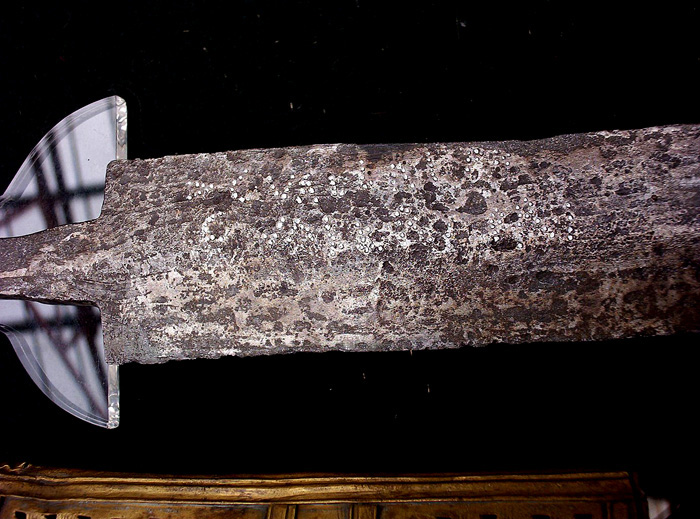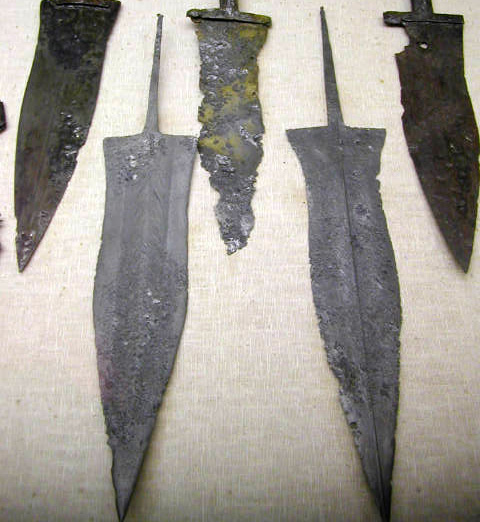Hi I have heard allot about piled stucture in the roman era and I was wondering how it was different from pattern welding?
Thnx
Z
It is only a personal theory, but, I suspect piling was most likely done to reduce brittleness in period pieces of bloomery iron. Many "piled" sections artifacts have very low levels of martensite/bainite (phases of metal grain structure that hardens and tempers well.) This suggests to me that they actually reduced carbon content during the piling process.
I have yet to form a sincere opinion on the historical purpose of pattern welding. It seems probable that it was a way of combining iron from different sources, and saving the known best "tool edge" materials for that edge region in the finished piece. The cosmetic beauty of it was commented on by early 5th century, and I suspect cosmetics were a real motivation for pattern welding then as it is now in our modern extremes of it.
I have yet to form a sincere opinion on the historical purpose of pattern welding. It seems probable that it was a way of combining iron from different sources, and saving the known best "tool edge" materials for that edge region in the finished piece. The cosmetic beauty of it was commented on by early 5th century, and I suspect cosmetics were a real motivation for pattern welding then as it is now in our modern extremes of it.
Right, I think I'm pretty sure what pattern welding is. But what is "piled structure" is it just merl folded over a bunch of times or something else?
| Zach Gordon wrote: |
| Right, I think I'm pretty sure what pattern welding is. But what is "piled structure" is it just merl folded over a bunch of times or something else? |
| Zach Gordon wrote: |
| Hi I have heard allot about piled stucture in the roman era and I was wondering how it was different from pattern welding?
Thnx Z |
Hi Zach...
Best I understand, "Piled" structure is when wires of iron and steely iron are piled and welded together. Can be seen in celtic swords. This thread may be of interest in this context:
http://www.myArmoury.com/talk/viewtopic.php?t=1485
Eventually wires became bars (billets) which were welded together side by side. I have heard that in celtic swords these bars were twisted (torsion), though I have never seen any pictures of these swords. I have seen a drawing of a celtic or celto-roman sword in an Osprey book that showed the tang twisted to make it thicker and stronger. I have often thought it might be this technique which inspired the idea of twisting the billets to make them thicker and help distribute and squeeze out slag deposits. IMHO is is when the billets are twisted that the term "pattern-welding" is used because as the fuller is cut through the whirls on the twisted bars it creates various patterns, from herring-bone like structures near the surface to star like patterns deeper in, to "blood-eddy" like circular patterns near the center. Also sections of the billets could be left straight while sections in between left straight, then these alternate sections can be arranged in various patterns side by side before welded together making a larger more complex line or checkerboard pattern across the blade core. Here is a link to illustrate this.
http://www.templ.net/english/making-blades.php
By first century A.D. there are Roman pugio blades with torsion pattern welding. But by late Roman times, as the bog finds, especially Illerup Adal, shows tremendous experimentation with pattern-welding, including what appears to be mosaic "damascus" like billets.

Pompeii Gladius with Piled Structure

Pugio blade with torsion pattern welding from first century A.D.

Illerup Gladius with torsion pattern welding.
Great post Kirk! I have been looking for Roman era examples of it.
I had read that Romans saw the Germanic tribes make blades with techniques that I would interpret as early pattern welding / forge combining different materials. This does not seem to be written down until around 200 A.D. But, I know that evidence of this in blade cross section from finds in North Italy Celtic villages goes back to around 5th or 6th century B.C.
I had read that Romans saw the Germanic tribes make blades with techniques that I would interpret as early pattern welding / forge combining different materials. This does not seem to be written down until around 200 A.D. But, I know that evidence of this in blade cross section from finds in North Italy Celtic villages goes back to around 5th or 6th century B.C.
Page 1 of 1
You cannot post new topics in this forumYou cannot reply to topics in this forum
You cannot edit your posts in this forum
You cannot delete your posts in this forum
You cannot vote in polls in this forum
You cannot attach files in this forum
You can download files in this forum
All contents © Copyright 2003-2006 myArmoury.com — All rights reserved
Discussion forums powered by phpBB © The phpBB Group
Switch to the Full-featured Version of the forum
Discussion forums powered by phpBB © The phpBB Group
Switch to the Full-featured Version of the forum